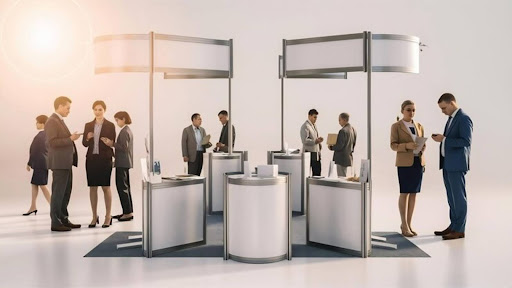As sustainability is more frequently front-of-mind in business today, brands are working towards finding smarter and greener ways to participate in trade shows without sacrificing visibility or impact. One major movement has been away from single-use, custom-built displays and towards modular and reusable options. A used trade show booth not only provides substantial cost savings but also provides environmental benefits, allowing organizations to reduce waste while giving their audience a lasting experience. For the contemporary exhibit, being environmentally conscious is equally as important as creative design; we can design booths that represent both the planet and the brand.
Sustainable exhibits are environmentally sensitive, using renewable materials, reusable elements, and compact logistics. There are numerous stages of development, from structural considerations to the packing and transportation of materials. Each design decision can speak to a brand’s values. When companies exhibit responsibility, they not only appeal to consumer concerns about the environment but also reap long-term cost savings and improved function. Companies that use sustainability to guide exhibition structures can also achieve greater awareness and recognition, as there continues to be a growing consumer demand for ethics in standardized practices.
Designing Trade Show Booths That Are Both Green and Impactful
1. Opting for Modular Trade Show Rental Booths
By using trade show rental booths that are built from a modular system, you can use your booth modifications at multiple shows and seriously reduce the cost of resources utilized. These booths are designed to change very easily, allowing brands to have a new look without needing to create a new booth from scratch at each event.
Using a modular system will also simplify and make transportation and setup processes easier and more energy-efficient. Renting rather than producing new structures for every trade show being exhibited reduces material use and reduces a brand’s carbon footprint—these are two significant advantages to be considered within an environmentally conscious business.
Embracing Recycled and Eco-Friendly Materials
Modern exhibits that utilize bamboo flooring, aluminum frames, and recyclable graphics can be made from environmentally friendly materials. Sustainable substrates, including tension fabrics and PVC-free graphics, leave behind fewer toxins and wastes.
From a design perspective, adding green materials does not mean compromising the visual elements of your design. In some cases, the inclusion of eco-friendly materials contributes positively to the clean and contemporary feel of your booth. Making sustainable selections can be as simple as selecting suppliers and builders who have environmental certifications and quality booths. Aesthetics and ethics can both be satisfied.
Designing for Reusability and Multi-Event Adaptability
A thoughtfully constructed booth should have enough versatility to function in different sizes and formats. This allows easier adaptation of the exhibit to unique show floor shapes and audience segments without complete rebuilds.
You can transition from one layout and audience demographic to another by using standardized panels, interchangeable graphics, and adjustable components. This not only supports the booth’s evolution with the brand but also keeps the brand identity similar. The more frequently a booth is used, the lower the per-use environmental cost; the act of reusability is a key principle of sustainable exhibiting.

Reducing Transport and Storage Emissions
Transportation is often the most resource-heavy part of trade show participation. Shipping lighter materials, compacting packaging materials, or using materials that are collapsible helps make shipping more efficient (i.e., less fuel used and lower shipping costs).
Similarly, modular designs or pop-up booth spaces (that may be packed into a smaller package) help to address the trade show component’s environmental burden associated with storage. Planning appropriate storage solutions—particularly with used trade show booths—considering how ready the booth will be for the next event without too much handling or repacking, allows for more conscious consumption, including resource usage.
Incorporating Digital and Paperless Engagement Tactics
By limiting the use of printed handouts, brochures, and other physical giveaways, a booth can significantly improve performance from a sustainability perspective. Instead of printed material, brands can use QR codes, interactive screens, or tablets to deliver content in a digital format to attendees, which reduces the use of paper and ink, and improves tracking and opportunities for follow-up.
Digital engagement tools also potentially take up less space, allowing the opportunity for more booth layout space to use for product demonstrations or for engaging visitors. Using technology as an eco-design feature reflects a progressive approach that aligns with modern consumer preferences.
End Point
Sustainability in trade show design is no longer an “It’s a special focus” element—it is quickly becoming an expectation in the industry. Brands can lessen their carbon footprint and still stand out on the show floor through modular construction, sustainable materials, and reuse mindset considerations for planning.
Practicing reusable and adaptable solutions, including thought-out design, ensures financial savings in the long run, but also demonstrates to the public and stakeholders its commitment to responsible business practices. Smart design results in smart impact—not only on the audience, the budget, and the planet!


